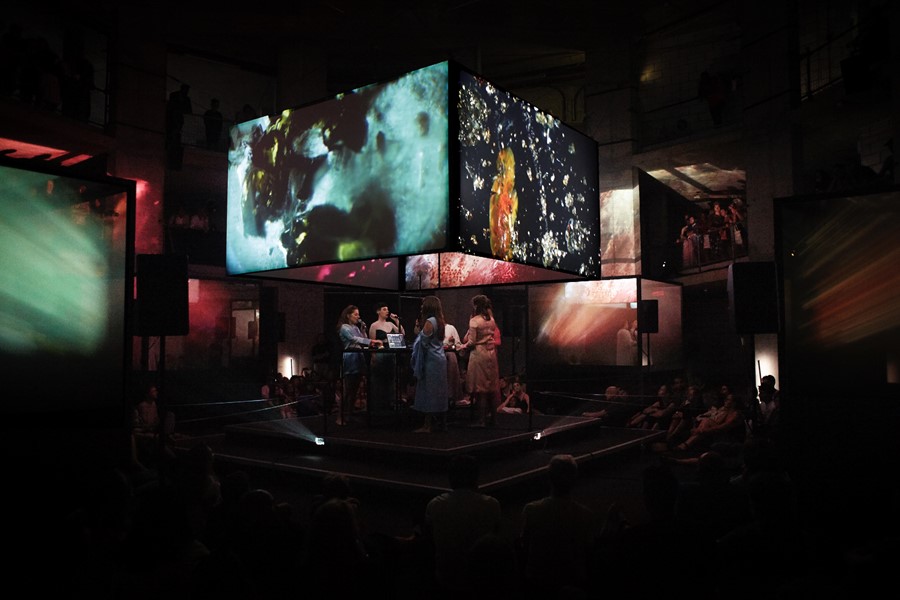NYX are the female drone choir who believe in the healing power of song
We speak to the choir’s composer and music director about their boundary-pushing work and how singing together can benefit your mind
Named after the omnipotent Goddess of Night, NYX (pronounced “nicks”) is an electronic drone choir that manipulate and modulate ordinary singing techniques in order to explore the full spectrum of what’s possbile with the vocal sound. Formed in 2017 in a small north London studio, the choir’s haunting sounds have already brought them widespread attention from critics and audiences alike.
Layering organic and synthetic voices, the choir create immersive and trippy sonic landscapes. That’s something you can hear on their first single “Void”, created for photographer Dan Tobin Smith’s multi-sensory installation piece of the same name (in collaboration with The Experience Machine and Gemfields). A conceptual exploration of gemstones, and the imperfections found within them, NYX provided an ethereal aural performance, recreating the stones’ ancient elemental energy.
By harnessing the void between nature and technology, the choir show us the creative possibilities of our 21st century relationship with electronics. While they utilise an impressive display of extended voice techniques, from reversed loops and heavy pitch shifts, a distinct human quality is still audible in NYX’s work. Community is truly at the heart of the collective. Despite the use of contemporary electronics, NYX taps into a very primal desire for a shared aural experience.
Speaking to Sian O’Gorman, the choir’s Composer and Music Director, we learned more about the enigmatic electronic drone choir; from reaching a higher state of consciousness to technical glitches and massage circles.
How did NYX form?
Sian O’Gorman: Our collective comes from an interesting collision of interests. Philippa and Josh (NYX Creative Directors) used to produce Convergence Festival – we wanted to look at ways to make live electronic music more performative. I was beginning to experiment with digital vocal manipulation on my own, and was looking to start a new group singing project where we could utilise both our voices and technology to create soundscapes together. Phillipa and I were put in touch with each other from a mutual friend and I looked to my existing singer friends for anyone interested. It began in a small north London studio messing about with vocal noises, guitar pedals, vocal processors, learning overtone singing, and then we began to develop a collective sound and creative space for each other.
Where does the name come from?
Sian O’Gorman: The name is a reference to the Goddess of the Night, and is a link to the darker parts of ourselves we are accessing and expressing through our voices and performance.
How do you believe the collective re-informs our concept of the traditional female choir?
Sian O’Gorman: The collective is underpinned by this drive to create vocal soundscapes with a full affective range. It’s about celebrating the ethereal and the terrifying, and finding the divine in both the delicate and the disgusting. Collective female voice is alive in many traditions, and we draw harmonic inspirations from many of these. For us, the choral experience feeds our music making process by combining organic and synthetic voices.
“It’s about celebrating the ethereal and the terrifying, and finding the divine in both the delicate and the disgusting” – Sian O’Gorman
NYX uses synthetic voice modulation to test the boundaries of collective female singing. Do you believe this is the future of singing, and where does this leave the natural voice?
Sian O’Gorman: The interest lies in the integration of natural, unique timbres of the human voice with technology. All of our singers bring a different vocal tone, and as this is processed and distorted, the sound is still unique to that singer. We’re applying both traditional and extended voice techniques with our acoustic voices, using breath, guttural sounds from the sinuses and throat, testing the corners of our linear ranges, mimicking animal sounds, creating vast soundscapes through the caverns of the mouth. When we then expand this out into synthetic manipulation, this is extended even further. We’re using reversed loops, time-warped vocal fry and heavily pitchshifted voices into deep sub bass. The digital augmentation expands the possibility of our collective timbre beyond what is possible with the standalone ‘natural’ voice, but the unique human quality of each singer is still very much shaping the sound.
The VOID installation aimed to embody the elemental energy emitted from gemstones, is nature an important source of inspiration for NYX?
Sian O’Gorman: There is a strong sense of the human body and its relationship to the natural world at the foundation of all of our compositions and performances. Whether that manifests sonically in a more literal sense, like through mimicking birdsong; becomes the foundation of visual scores or song structures, cell-shaped arrangements and narratives involving microorganisms; or sits at the centre of our performative intentions, connecting the body to the crystalline cores of the Earth.
As well as performing, you conduct research into sonic immersion. Tell me about the benefits this can have on your mental health.
Sian O’Gorman: The mental health focus for us lies predominantly in the power of collective singing, sound making, and holding space for one another. The oxytocin released when singing activates feelings of trust and deep bonding, so when we sing together that sense of acceptance and love is amplified tenfold. The act of simultaneously creating and being part of a collective, organic sound source shifts us up to a higher state of consciousness – it helps us to access a space where we truly feel part of something bigger than ourselves. It’s also this sense of belonging that takes us back to our origins as a communal species. We have a number of techniques we use in combination with music making that help with this connection too – namely the visualisation of colours and images into the areas of the body that we use to sing; massage circles to connect with and calm one another physically; and shaking and vibrating to ground and centre ourselves before performance.
“The oxytocin released when singing activates feelings of trust and deep bonding, so when we sing together that sense of acceptance and love is amplified tenfold” – Sian O’Gorman
The collaborative provides an immersive way of experiencing music – how do you feel emotionally and physically when performing to a live audience?
Sian O’Gorman: On stage, there is a strong connection between all of us, and we ebb and flow together through the music. Emotionally we try to accept and embody everything we’re feeling – whether that’s anxiety, joy, sadness, or anger, and we feed that out through our voices. Our first performance was only a year ago, and there are still flickering moments of terror on stage when things go wrong but we’re learning to flow with these and remain connected to each other and our audiences. More often now we’re brought to tears when performing with each other – with an overwhelming sense of love and connection.
What’s next from NYX?
Sian O’Gorman: Lots. Right now we’re developing music for a new live show with the wonderful composer and artist Christina Vantzou, as part of a commission from Kings Place that will feature in their 2020 Luminate series. We’re also putting the finishing touches onto our next single and an album we recorded with Gazelle Twin towards the end of last year called Deep England, those will both be released in the coming months. We have lots of live dates and other projects to announce this year, follow us on Instagram to keep up to date.
Source: NYX are the female drone choir who believe in the healing power of song | Dazed













